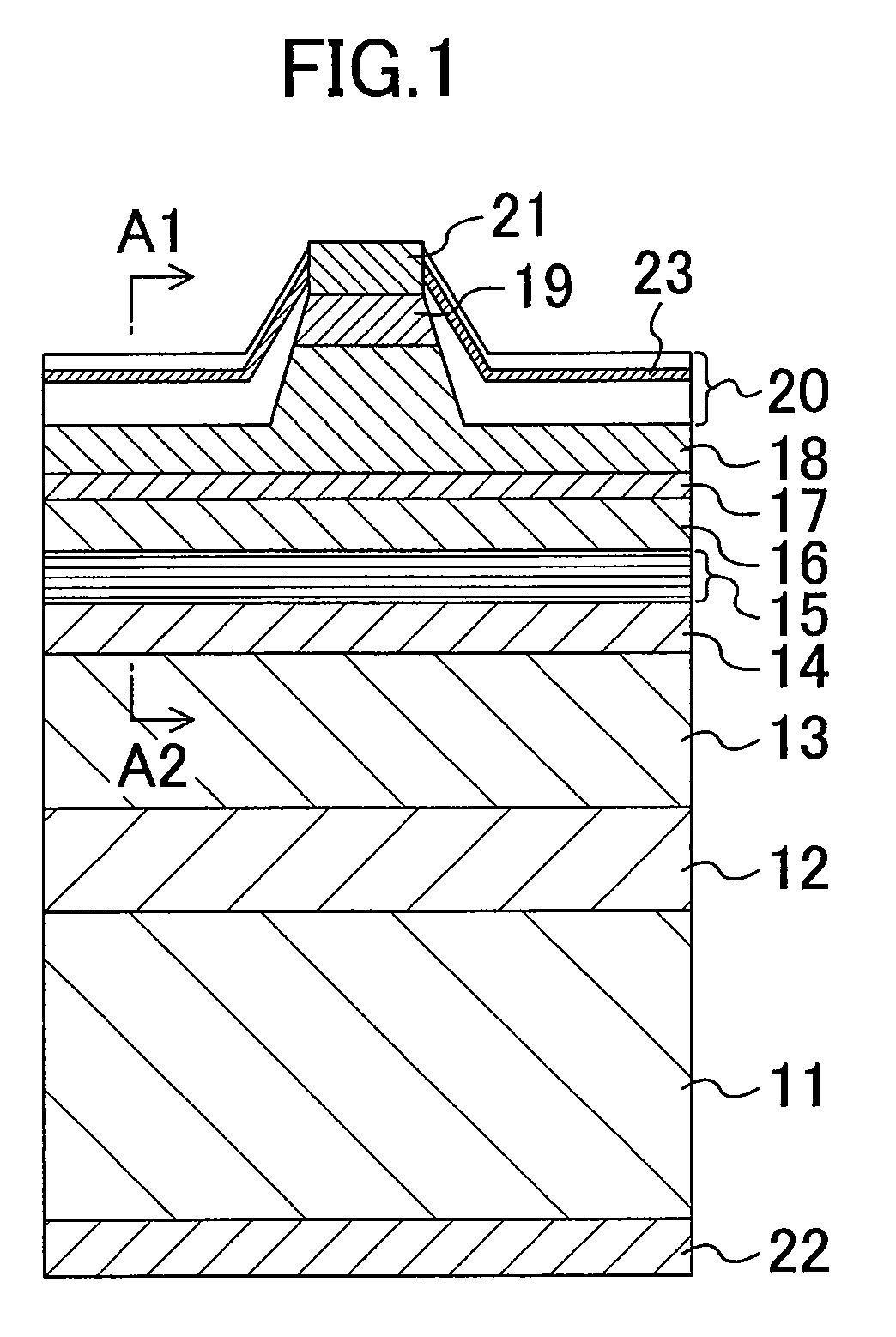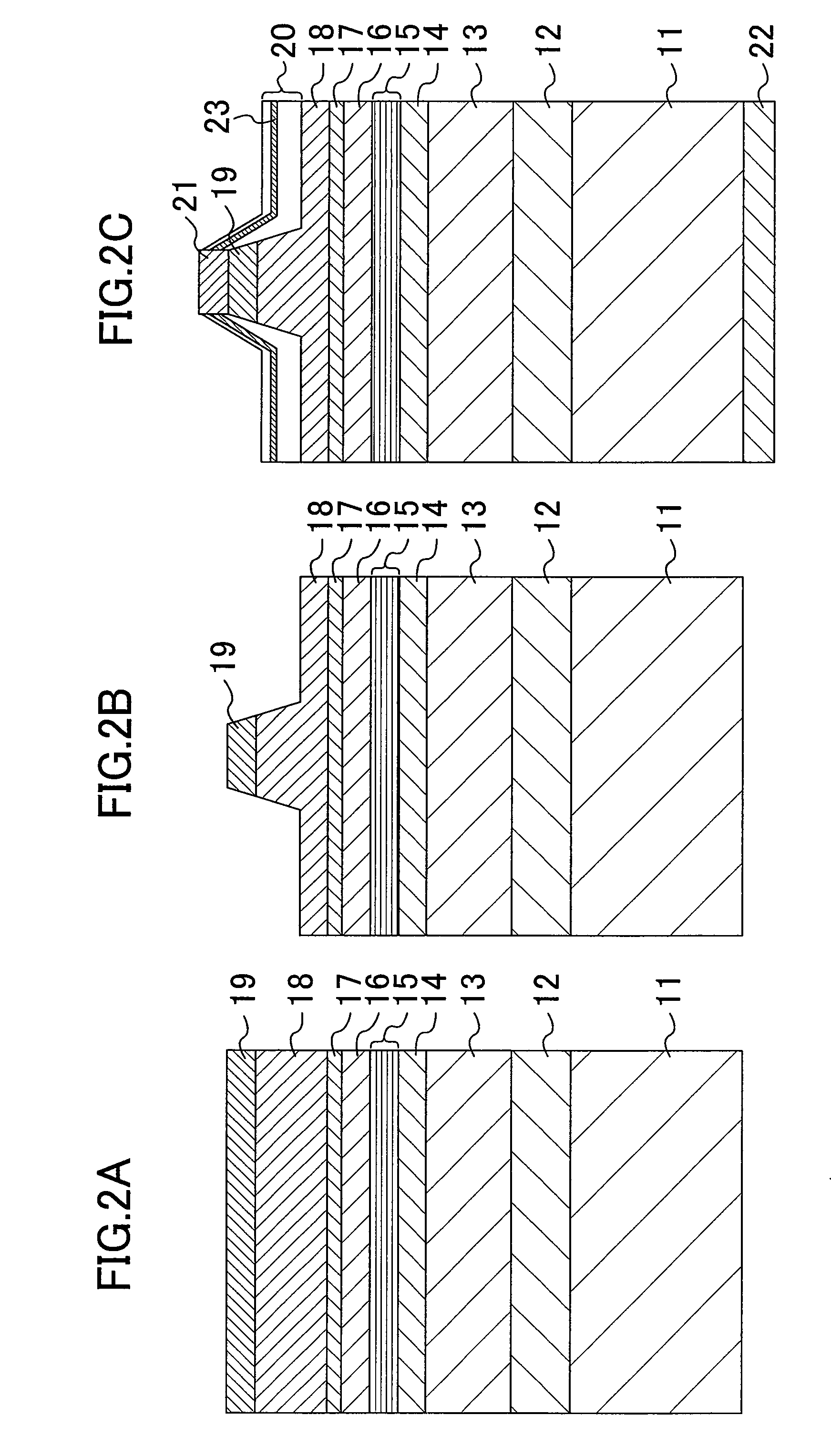Nitride semiconductor device and manufacturing method thereof
a technology of semiconductor devices and semiconductor layers, applied in semiconductor devices, semiconductor lasers, lasers, etc., can solve the problems of increased operating voltage, electron overflow, increased operating current, etc., and achieve the effect of reducing the concentration of residual hydrogen in the p-type semiconductor layer
- Summary
- Abstract
- Description
- Claims
- Application Information
AI Technical Summary
Benefits of technology
Problems solved by technology
Method used
Image
Examples
first embodiment
[0037]Hereinafter, a nitride semiconductor device according to a first embodiment of the present invention will be described with reference to the accompanying drawings.
[0038]FIG. 1 is a diagram showing a cross-sectional structure of a semiconductor laser device (nitride semiconductor device) according to the first embodiment of the present invention. As shown in FIG. 1, in the semiconductor laser device of the present embodiment, an n-type GaN layer 12, an n-type cladding layer 13 made of n-type AlGaN, an n-type optical guide layer 14 made of n-type GaN, a multiple quantum well active layer 15 made of InGaN, a p-type optical guide layer 16 made of p-type GaN, an electron blocking layer 17 made of p-type AlGaN, a p-type cladding layer 18, and a contact layer 19 made of p-type GaN are sequentially formed from bottom to top on a top surface of an n-type GaN substrate 11. Note that operation as a semiconductor laser device is not affected even when the p-type optical guide layer 16 and...
second embodiment
[0087]A nitride semiconductor device according to a second embodiment of the present invention will now be described with reference to the figures.
[0088]FIG. 7 shows a cross-sectional structure of the semiconductor laser device of the second embodiment. Note that FIG. 1 shows a longitudinal section vertical to the ridge waveguide (a longitudinal section vertical to the light emitting direction), while FIG. 7 shows a longitudinal section parallel to a ridge waveguide near a light emitting end on the front side of the semiconductor laser device (a longitudinal section parallel to the light emitting direction).
[0089]In the semiconductor laser device shown in FIG. 7, the structure of an n-type GaN substrate 11, an n-type GaN layer 12, an n-type cladding layer 13, an n-type optical guide layer 14, a multiple quantum well active layer 15, a p-type optical guide layer 16, an electron blocking layer 17, a p-type cladding layer 18, a contact layer 19, a p-side electrode 21, and an n-side ele...
third embodiment
[0103]A nitride semiconductor device according to a third embodiment of the present invention will now be described with reference to the figures.
[0104]FIG. 9 shows a cross-sectional structure of a semiconductor laser device according to the third embodiment. More specifically, FIG. 9 shows a longitudinal section parallel to a ridge waveguide near a light emitting end on the front side of the semiconductor laser device (a longitudinal section parallel to the light emitting direction). The semiconductor laser device of FIG. 9 has the same structure as that of the semiconductor laser device of the second embodiment shown in FIG. 7 except for a second impurity region 23b.
[0105]The semiconductor laser device of the present embodiment is characterized in that the second impurity region 23b containing fluorine is formed near the mirror face 24 that is an interface between the insulating film 30 and each nitride semiconductor layer.
[0106]In a B1-B2 section, the second impurity region 23b ...
PUM
| Property | Measurement | Unit |
|---|---|---|
| temperature | aaaaa | aaaaa |
| width | aaaaa | aaaaa |
| length | aaaaa | aaaaa |
Abstract
Description
Claims
Application Information
 Login to View More
Login to View More - R&D
- Intellectual Property
- Life Sciences
- Materials
- Tech Scout
- Unparalleled Data Quality
- Higher Quality Content
- 60% Fewer Hallucinations
Browse by: Latest US Patents, China's latest patents, Technical Efficacy Thesaurus, Application Domain, Technology Topic, Popular Technical Reports.
© 2025 PatSnap. All rights reserved.Legal|Privacy policy|Modern Slavery Act Transparency Statement|Sitemap|About US| Contact US: help@patsnap.com



